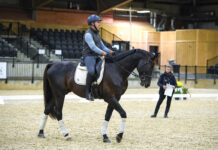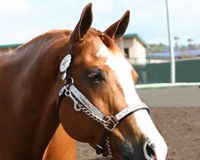 Hunter/jumper trainer Susan Smith |
For over 20 years, Sue Smith has trained hunters, jumpers and equitation mounts from her Cornerstone Equestrian Center in Riverside County, Calif. She also holds an M.S. in Animal Science with an emphasis on learning behavior in horses from Cal Poly Pomona. A good portion of her training includes a focus on flat work basics, including flying lead changes. Her clients are amateur hunter/jumper riders who compete successfully at county and nationally rated horse shows. With her varied background, she provides a unique perspective on how to achieve consistent flying changes.
Probably the most common mistake riders make is leaning to the inside of a turn. The horse lands on the wrong lead after a jump and the rider subconsciously tries to help the horse get his change by tipping forward and leaning over the horse’s inside shoulder. That causes the horse to drift in, off the straight track, and start turning too soon. He’ll be crooked and unbalanced with his weight on his front end, so he either misses the change entirely or only switches in front.
As a fix, I remind my riders to continue riding a straight track after the jump. I tell them to pull their inside shoulder back and stretch up or grow through their upper body. This strengthens their position so they can half-halt better and balance their horse for the change. Then I remind them to step down in their outside stirrup. That also keeps them centered in the saddle so they’re less likely to lean to the inside.
If a new student is eager to jump more advanced courses but is still struggling with flying changes, how would you help her?
First of all, if she’s on a green horse that doesn’t yet have solid flying changes, I’d put her on a school horse, like a retired medal horse, that pretty much does his changes as long as he’s set up properly. Then she can go through the learning process and make mistakes without the added stress of worrying that she’s messing up her green horse.
My main focus with this rider, though, would be working on simple lead changes, which include all the elements of a flying change broken down step by step. To perfect simple changes, the rider has to coordinate her leg and rein aids. She has to be able to create a bend yet also ride a straight line. Once she can consistently execute proper simple changes, flying changes come pretty easily. Then I’ll continue to coach her through the process of re-introducing flying changes. I’ll talk her through the steps, giving her reminders like, “Straight, straight, balance, balance … change!” After a while, she’ll start saying these reminders to herself, and the steps she has to go through to get the flying change will become ingrained and automatic.
Besides rider errors, there are training issues. For example, some horses only seem to switch their lead in front, so they end up cross-cantering. What causes that, and how do you fix it?
In general, it’s due to two things: a lack of engagement of the horse’s hindquarters, and the horse falling in, which means he has strayed inward off the straight track and is starting to turn before he has reached the corner.
To fix this common problem, I remind my students to have a plan for every course. They need to know when they’re going to need a lead change–a sort of deadline. Then they have to continue to ride a straight track after each jump until they get to that point. They have to balance their horse by compressing or collecting his stride to gain some impulsion and push from his hindquarters before asking for the change. When a horse is properly set up, he will perform a clean, complete change.
Another problem is the horse that gets strong and gallops off before the rider can even ask for a change. What creates that scenario? Can that type of horse be fixed?
Sensitive, intelligent horses that are drilled on flying changes can start anticipating them and get quick and anxious. These types of horses are already overachievers, so once they have their changes, stop practicing them. When you’re schooling for a show, or in the warm-up ring before a class, get a change in each direction and be done with it.
However, there are other horses that develop dangerous behaviors like the ones you described. Most of the time, it starts because the horse was physically forced into doing flying lead changes before he really grasped the concept. The whole topic has been a battle from the beginning, so the horse has become evasive and resistant. You need to re-school this type of horse by first slowing and collecting him at the canter. That doesn’t mean reaching for a stronger bit or some kind of gadget. Focus more on flatwork fundamentals, like leg-yields and simple changes, to get him balanced and soft and supple to your aids. The moment he gets quick, especially after a jump, do a downward transition. Eventually, with time and patience, you can re-introduce flying lead changes in a kinder, gentler fashion.
Further Reading
Flawless Flying Lead Changes






